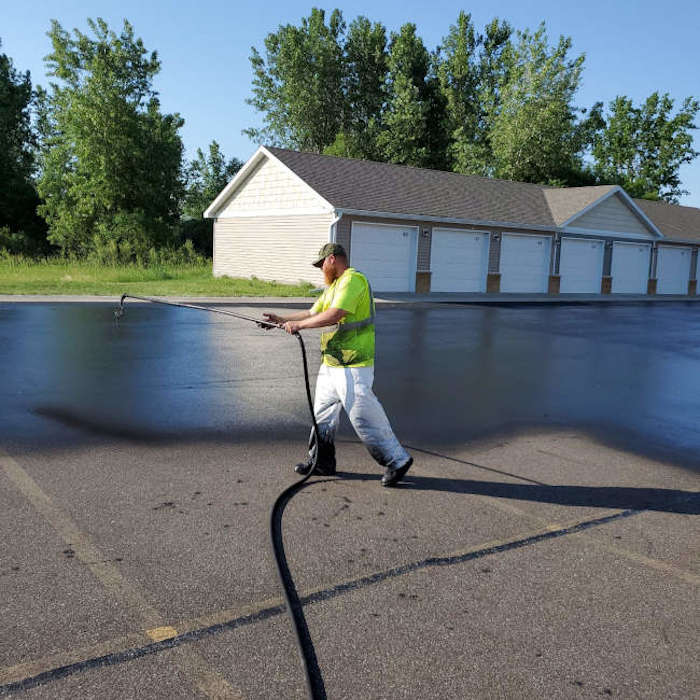Elevate Commercial Allure: Warm Mix Asphalt Sealing for Angled Parking Lots
Elevate Commercial Allure: Warm Mix Asphalt Sealing for Angled Parking Lots
Blog Article
Hot Mix Asphalt: A Sustainable Remedy for Sidewalk
Hot Mix Asphalt (HMA) has actually emerged as a leading sustainable selection for pavement services, providing a myriad of ingenious innovations and environmental benefits. As the demand for eco-friendly building and construction methods grows, checking out the nuances of HMA's sustainability can supply valuable insights into the future of sidewalk options.
Environmental Advantages of Hot Mix Asphalt

Furthermore, Warm Mix Asphalt helps to minimize metropolitan heat island results. Its dark shade soaks up sunshine, decreasing the amount of warm showed back into the atmosphere contrasted to lighter-colored sidewalks. This can reduce ambient temperature levels in city locations, lowering the need for cooling and inevitably reducing energy intake.
Additionally, Warm Mix Asphalt adds to enhanced stormwater management. Its permeable nature enables water to infiltrate the pavement and recharge groundwater materials, reducing overflow and the threat of flooding. These ecological benefits make Hot Mix Asphalt a lasting choice for leading freeways and roadways.
Energy Performance in HMA Production
Is power effectiveness an essential aspect in the production of Hot Mix Asphalt (HMA)? Energy plays a significant role in the manufacturing of HMA, influencing both price and ecological sustainability. One essential element of energy performance in HMA production is the usage of warm mix asphalt (WMA) modern technologies.
Additionally, advancements in plant modern technologies have led to more energy-efficient HMA manufacturing procedures. By maximizing energy usage in HMA production, the market can reduce its carbon impact while maintaining top quality sidewalk materials.
Recyclability of Warm Mix Asphalt
The recyclability of Hot Mix Asphalt (HMA) is a pivotal aspect of its sustainability and long-lasting ecological influence. HMA is just one of one of the most recycled products in the United States, with over 100 million heaps of recovered asphalt pavement (RAP) being reused yearly in new pavement construction. Reusing HMA provides numerous ecological advantages, such as minimizing the need for virgin products, lowering power intake throughout manufacturing, and reducing the amount of waste sent out to garbage dumps.
The procedure of recycling HMA includes grating the existing pavement, squashing it into smaller sized items, and mixing it with brand-new accumulation and asphalt binder to develop a recycled mix. This recycled mix can often do in addition to or even better than traditional HMA, while requiring fewer resources and producing lower great site greenhouse gas emissions. By including RAP into new pavement projects, road agencies can conserve natural deposits, reduce expenses, and reduce the environmental footprint of road building and upkeep activities. In general, the recyclability of HMA plays a significant duty in promoting sustainable techniques within the sidewalk market.

Long-Term Performance of HMA
Asphalt sidewalks demonstrate toughness and resilience over an extended period, showing the long-lasting performance of Hot Mix Asphalt (HMA) The long life of HMA can be attributed to its capacity to withstand rush hour lots, rough weather, and the impacts of aging. visit site Studies have actually shown that properly designed and effectively built HMA pavements can last for 20 years or more with normal maintenance. The trick to making the most of the lasting performance of HMA hinges on making use of top notch materials, complying with best practices in construction, and executing effective upkeep strategies. Appropriate water drainage, regular evaluations, and timely repairs are vital for preserving the structural honesty of HMA sidewalks over time. Furthermore, improvements in HMA modern technology, such as using polymer-modified binders and cozy mix asphalt, have even more enhanced the durability and durability of HMA pavements. By prioritizing quality building and construction and upkeep methods, HMA proceeds to show itself as a affordable and lasting option for durable pavement facilities.

HMA: Resilience and Sustainability
Demonstrating both longevity and sustainability, Hot Mix Asphalt (HMA) has become a cornerstone in the building and construction of lasting pavement infrastructures - commercial parking lot paving. HMA's sturdiness comes from its capability to withstand heavy lots, extreme weather, and high web traffic quantities, making it a trustworthy choice for roads, highways, and airport terminal paths. The make-up of HMA, which usually consists of aggregates, binder, and filler, plays a critical role in enhancing its longevity and resistance to tear and put on
Moreover, HMA's sustainability this website lies in its recyclability and energy-efficient production process. The capacity to reuse recovered asphalt pavement (RAP) in brand-new HMA combinations decreases the need for virgin materials and lessens the ecological impact of pavement construction and upkeep. Additionally, the power effectiveness of producing HMA lies in its lower mixing temperatures contrasted to other sidewalk materials, resulting in lowered power consumption and greenhouse gas discharges.
Verdict
In conclusion, warm mix asphalt (HMA) supplies a sustainable service for pavement with its ecologically friendly characteristics. HMA's recyclability, power effectiveness in manufacturing, and lasting sturdiness make it an eco-friendly choice for roadway building. By preserving natural deposits, minimizing waste, and lowering greenhouse gas exhausts, HMA plays a vital role in promoting sustainability in facilities advancement. Its ability to alleviate metropolitan warmth island impacts even more highlights its significance in developing environmentally aware and resistant pavement systems.
HMA is one of the most recycled products in the United States, with over 100 million heaps of redeemed asphalt sidewalk (RAP) being reused annually in new sidewalk building.The process of reusing HMA includes grating the existing sidewalk, squashing it right into smaller sized pieces, and mixing it with brand-new accumulation and asphalt binder to produce a recycled mix.Asphalt sidewalks show sturdiness and resilience over a prolonged duration, showing the long-lasting efficiency of Hot Mix Asphalt (HMA) Additionally, innovations in HMA technology, such as the usage of polymer-modified binders and warm mix asphalt, have actually better improved the toughness and long life of HMA sidewalks. The capacity to reuse recovered asphalt sidewalk (RAP) in new HMA combinations decreases the demand for virgin materials and minimizes the ecological impact of sidewalk construction and maintenance.
Report this page